Seven Periods of Western Art in the Common Era
When I look at the major periods of Western Art History, the one thing that stands out to me is that artists have been creating art for a long time. Western Artists have been creating art for literally thousands and thousands of years.
The major Western fine art history periods are defined as Prehistoric Art, Ancient Art, Medieval Fine art, the Renaissance, Mannerism, Bizarre, Rococo, Neoclassicism, Romanticism, Realism, Art Nouveau, Impressionism, Postal service – Impressionism, Fauvism, Expressionism, Cubism, Surrealism, Abstruse Expressionism, Op Art, Popular Art, Arte Povera, Minimalism, Conceptual Fine art and Contemporary Art.
There are 24 basic western art history flow timelines. Each 1 covers a dissimilar blazon of fine art and a specific timeline or era.
Below is a nautical chart to show the Western Art history periods and the years each of them covers.
| Fine art History Period | Years |
| Prehistoric Fine art | -40,000 – iv,000 B.C. |
| Ancient Art | 30,000 B.C. – A.D. 400 |
| Medieval Art | A.D. 500 – A.D. 1400 |
| Renaissance | 1400 – 1600 |
| Mannerism | 1527 – 1580 |
| Baroque | 1600 – 1750 |
| Rococo | 1699- 1780 |
| Neoclassicism | 1750 – 1850 |
| Romanticism | 1780 – 1850 |
| Realism | 1848 – 1900 |
| Fine art Nouveau | 1890 – 1910 |
| Impressionism | 1865-1885 |
| Post – Impressionism | 1885-1910 |
| Fauvism | 1904-1908 |
| Expressionism | 1905- 1920 |
| Cubism | 1907 – 1914 |
| Surrealism | 1916-1950 |
| Abstruse Expressionism | 1940s – 1960s |
| Op Art | 1950s – 1960s |
| Pop Art | 1950s – 1960s |
| Arte Povera | 1960s – 1970s |
| Minimalism | 1960s – 1970s |
| Conceptual Art | 1960s – 1970s |
| Contemporary Art | 1970 – present |
Art History Menstruation and Western Art Movements
Each of these Western Art History periods is a chip dissimilar from the other. Below is a summary of each of these Western Art History timelines and periods.
Prehistoric Fine art
Prehistoric fine art covers the period from-forty,000 – four,000 B.C. This period is and then long that it covers all art forms until a defined culture or culture. Many do not consider this as western art, merely we include it here as cavemen drawings were also constitute in Europe.
Prehistoric art as well includes art forms such equally writing, recordkeeping, or art found on cave walls. The cavemen drawings is an art form that dates back to prehistoric art and is plant worldwide.
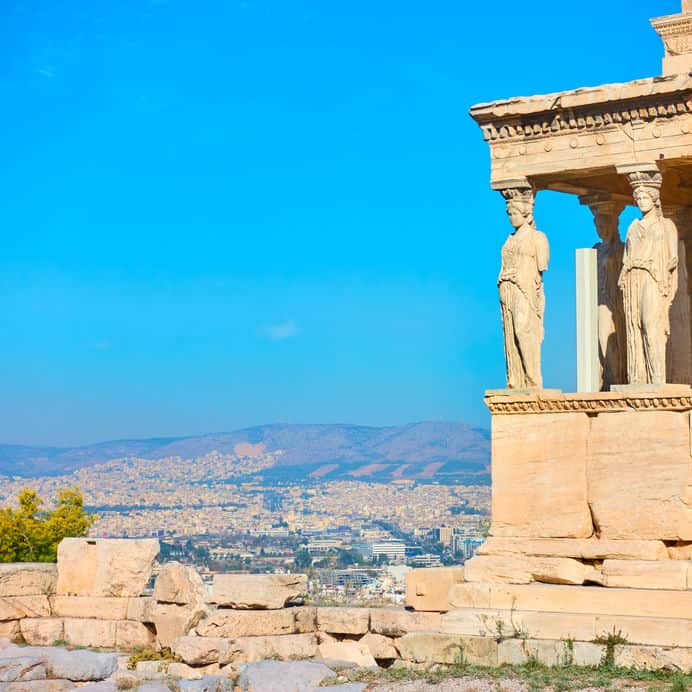
Ancient Fine art
Like the prehistoric art, the Ancient Arts as well cover a large span of fourth dimension from thirty,000 B.C – A.D. 400. Again, aboriginal art is found in many parts of the globe.
Some of the more than famous Western Classical Arts are the Ancient Western Classical Art of the Minoans, Greeks, and Romans civilizations. Yous can notice more than about this art period by reading our blog What Are The Ancient Western Classical Arts? A Quick Guide by clicking hither.
Medieval Art
Medieval Fine art covers the period of art from A.D. 500 – A.D. 1400; western medieval art covers nearly 1,000 years of art throughout Europe. This art time frame covers a vast assortment of art.
Like many other art timelines, medieval art has been broken downwardly to other art timelines such as Early Christian art, Migration Flow fine art, Byzantine art, Insular fine art, Pre-Romanesque, Romanesque, and Gothic art. There is also Anglo-Saxon fine art and Viking Art, which fit into the Western Medieval art realm.
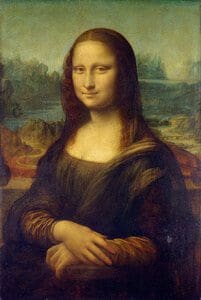
Renaissance Fine art
Renaissance Art is the painting, sculpture, and decorative arts of European history from almost 1400 – 1600. Also parallel to the artistic move was the advancement in philosophy, literature, music, science, and engineering science.
Renaissance art took the foundation of its fine art from classical antiquity but transformed the art by applying current knowledge of the twenty-four hour period. The menstruum of Renaissance art is meaning every bit it marks Europe's transition from medieval art to the early modern art age.
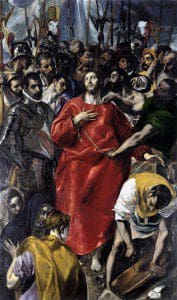
Mannerism (Late Renaissance)
The Mannerism art move took place from 1527 – 1580. This period of art is also known every bit the belatedly Renaissance.
Mannerism art exaggerated the qualities of proportion, balance, and ideal dazzler. For example, an artist may make a neck longer than what it originally was. Thus, the mannerism art flow is known for its intellectual sophistication and some of its artificial qualities.
Baroque
The Baroque period of art is from 1600 – 1750. The Bizarre way includes architecture, music, dancing, painting, sculpture, and other arts. Bizarre art flourished in Europe. Information technology began in Rome only then rapidly spread into French republic, northern Italy, Spain, Portugal, and Europe.
The baroque manner used contrast, movements, exuberant details, deep colors, grandeur, and surprise for the viewer to have a sense of awe. It is as well known for its excessive use of ornament.
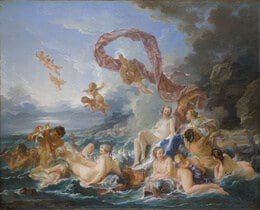
Rococo (Belatedly Baroque)
The Rococo period of art is from 1699- 1780. It is also known as the Late Baroque period of fine art.
The Rococo or Late Baroque fine art movement is an exceptionally ornamental and theatrical style of architecture, art, and decoration. This fine art movement combines asymmetry, scrolling curves, and gliding along with pastel colors— sculpture molding and trompe l'oeil frescoes.
Like the Baroque fine art movement, the chemical element of surprise was important, along with movement and drama. This is why many consider Rococo as the concluding expression of the baroque movement of art.
Neoclassicism
Neoclassicism was for about a 100 yr menstruation from 1750 – 1850. Information technology was a movement that started in Rome and spread around Europe.
The Neoclassicism movement coincided with the 18th Century Historic period of Enlightenment. Neoclassicism took a lot of its inspiration from the ancient arts of Rome and Greece. For example, Neoclassicism architecture was based on simplicity and symmetry.

Romanticism
The Romanticism art movement was from 1780 – 1850. It ran parallel together with the Neoclassicism fine art movement. It is also known equally the Romantic Era.
The Romanticism fine art motility was an creative, literary, musical, and intellectual movement that originated in Europe. An emphasis on emotion and individualism characterized it. It took its inspiration from the Medieval period of art and not classical art. The art was a reaction to the industrial revolution and the social aspects of its day.
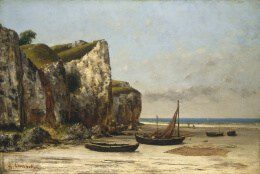
Realism (Naturalism)
Realism art was from 1848 – 1900. Information technology is sometimes too referred to as naturalism.
Realism fine art is about representing the subject matter truthfully and without whatever artificiality. The artist was to avert speculative fiction or any supernatural elements. Basically, it is about painting what you see and as existent as possible.
Art Nouveau
Art Nouveau was from 1890 – 1910. Art Nouveau was an art grade that caught on throughout Europe.
Art Nouveau's major objective was to break down the traditional distinction betwixt fine fine art and applied arts. Because of this, Art Nouveau was nigh widely used in interior pattern, graphic arts, piece of furniture, glass art, textiles, ceramics, jewelry, and metalwork.
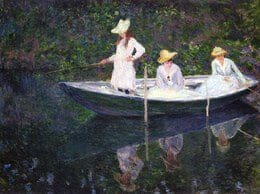
Impressionism
Impressionism was from 1865-1885. The impressionist fine art movement started in France but and then began to spread to other places. The impressionist artists faced harsh criticism from the established art customs in France.
Impressionism was characterized by relatively small thin visible brushstrokes with an open composition. The impressionist emphasized the delineation of light and its irresolute qualities, i.eastward., how light would change with time.
To find more about the Impressionism fine art movement, you lot tin read our blog Why Was Impressionism Fine art at Outset Rejected? by clicking here.
Post – Impressionism
The Post- Impressionism fine art movement was from 1885-1910. Information technology was a predominantly French fine art movement.
Post- Impressionism was a reaction against the impressionist concern for the naturalistic delineation of light and color. Post-impressionism extended impressionism while at the same time rejecting many of the limitations of impressionism. They continued using bright colors, thick application of paints, and real-life subject matters. They also used geometric forms or distorted forms for an added effect and used unnatural or arbitrary colors.

Fauvism
Fauvism was an art movement from 1904-1908. Fauvism is also known as les Fauves, which is French for "wild beasts." It was a short-lived motility as it only had iii exhibitions.
The Fauvism painters used wild brushstrokes and strident colors. At the same time, their subject matter had a loftier degree of simplification or brainchild.
Expressionism
The expressionism art movement was from 1905- 1920. This move started in Germany.
The Expressionism art move encompassed both poetry and painting. The Expressionist sought to represent the world from a subjective perspective. In their view, they distorted the earth for an emotional effect; their goal was to evoke feelings, ideas, and moods. Expressionists sought to express an emotional experience rather than physical reality.
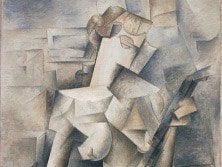
Cubism
The Cubism fine art movement was from 1907 – 1914. It was an avant-garde motility that was considered revolutionary for its time.
In the Cubism art motion, the objects were broken up, and so reassembled in an abstract form. Instead of depicting an object from a single viewpoint, they would show the object from multiple perspectives.
To learn more most the Cubism fine art movement, you tin can read our blog on The Cubism Art Motility, What Y'all Need to Know by clicking here.
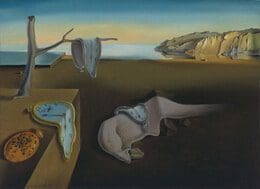
Surrealism
The Surrealism art movement was from 1916-1950. Surrealism was a cultural movement that started in Europe in the aftermath of World State of war I.
Surrealism is about the contradiction between dreams and reality – a kind of super-reality of surreality. Artists would paint unnerving scenes with photographic precision while they created strange creatures from everyday objects. They believed this allowed the unconscious to limited itself.
To discover more about Surrealism, you can read our blog Was the Mexican Artist Frida Kahlo (1907-1954) A Surrealism Artist? by clicking hither.
Abstract Expressionism
The Abstract Expressionism art motility is from the 1940s to – 1960s. Abstract Expressionism was a post World War Two method of painting that started in New York City.
Abstract Expressionism was the term that was applied to a new form of abstract fine art. Gestural brushstrokes and very spontaneous movements frequently narrate Abstruse Expressionism fine art. There were two main groups in Abstruse Expressionism 1) the action painters who worked in a spontaneous improvised style on the canvas and 2) the color field painters who painted simple compositions that had one color that filed a large part of the canvas.
One of the developers of the Abstruse Expressionism art movement was Jackson Pollock. You can larn more about him by reading our blog Who is the American artist Jackson Pollock (1912-1956)? past clicking here.

Op Fine art (Optical Fine art)
Op Art which is brusque for optical fine art had its major era in the 11950s to 1960s. The Time Magazine coined the term Op Fine art in 1964.
Many of the Op Art pieces are created in black and white; sometimes, they have a fleck of color. The Op Art gives the viewers the impression of move, hidden images, flashing, vibrant patterns, swelling, or the canvas's warping.
Learn more near Op Fine art by reading our blog What Are The Cardinal Characteristics of Op Art? by clicking hither.
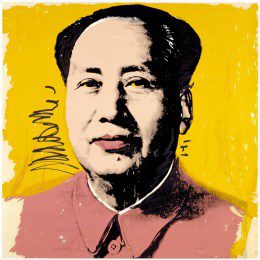
Pop Art
Pop Fine art is an fine art movement that emerged in the United States and United Kingdom in the 1950s and 1960s.
Pop Art would use images from pop and mass civilisation. One of the purposes of Pop Art was to use these images in an ironic or kitschy way. Many of the Pop Fine art images were imitated from pop imagines used in advertising.
To discover more about Pop Art you can read our blog What Is Popular Fine art In Simple Terms? by clicking hither.
Arte Povera
The Arte Povera art motility took place in the 1960s and 1970s. It started in major cities throughout Italy, with Turin, Italy being a major location.
The words Arte Povera ways "poor art.' This was about the artists using a broad range of materials besides traditional painting methods with oils on sheet. The art movement was considered a radical move as artists would explore the unconventional processes and not-traditional ways to use everyday materials. The artist would use everyday objects for their art as soil, rags, and twigs considered throw-away items.

Minimalism
The Minimalism art movement was in the 1960s and 1970s. The minimalism art was also referred to as minimal art, literalist fine art and ABC fine art.
This Minimalism art movement is most strongly associated with the visual arts in America. The Minimalism fine art scene encompassed art and design, visual art, and music. Some of the Minimalism artwork was equanimous of elementary geographic shapes that were usually based upon the foursquare and rectangle. Minimalist artists felt that fine art should take its ain reality and non be an fake of something else.
Conceptual Art (Conceptualism)
The Conceptual art movement took place in the 1960s and 1970s. Conceptual art is besides known as Conceptualism.
Conceptual art believes that the concept behind the artwork is more of import than the finished artwork or object. A Conceptual creative person will expect at an idea and then use the most advisable material to get his thought across. This could be anything from photography- to functioning – to a written description. Some conceptual artists would use "found" objects to express their ideas. For the Conceptual creative person, there is no unmarried course, style, or textile for the artwork.

Gimmicky Art
Gimmicky Fine art is started in the 1970s; information technology is s broad term given to today's art.
Gimmicky artwork is the art that reflects upon our globally-connected, culturally various earth that is rich with technology. While at the aforementioned time, Gimmicky art commonly reflects upon the artist'due south personal, culture, family, customs, and nationality. Contemporary fine art uses a dynamic combination of materials, concepts, methods, and subjects. Contemporary Art continues to alter and evolve as the globe also continues to alter and evolve.

When you look at this art timeline, one thing that stands out is that art and artists have been making the world a more than beautiful and interesting place for a very, very long fourth dimension. In fact, fine art has been effectually since the beginning of time. For any artist looking to explore a form of art, know that y'all're not alone. There take been many who take come up before you.
Related Concept
Can I Almost Visit Any Fine art Museums?
Many of the world's great art museums and galleries offer virtual tours of their museum or role of the museum. This is a great style to be able to see many of the world'due south finest art museums correct from the condolement of your dwelling.
You can discover more by reading our blog xi Virtual Art Museum Tours That Volition Cost You Nothing by clicking here.
What is the Brigham Young Academy Museum of Art?
The Brigham Young Academy Museum of Art is a world-grade art museum located in Provo, Utah. The museum exhibits artwork from many well-known artists. The Brigham Young Academy Museum of Art is i of the largest and best-attended art museums in the Mount West.
You tin discover more by reading our blog mail The Brigham Young Academy Museum of Art In Provo, Utah by clicking here.
rodriquezauntrand1975.blogspot.com
Source: https://anitalouiseart.com/what-are-the-major-periods-in-western-art-history/#:~:text=The%20major%20Western%20art%20history,Op%20Art%2C%20Pop%20Art%2C%20Arte
Post a Comment for "Seven Periods of Western Art in the Common Era"